The Achievement of Women's Suffrage in the United Kingdom
Part 2: Laws on the Books

Four years later, the National Union of Women's Suffrage Societies arose from the merger of a number of similar groups. The most well-known member of the society was Millicent Fawcett. The members of the NUWSS preferred to follow a constitutional path to success. They wanted the law to change and believed that legal means of advancing their arguments were more effective than the sort of outlandish, even violent methods employed by members of other suffrage organizations. 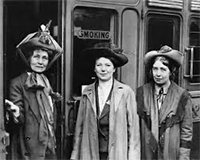
Out of that group came the Women's Social and Political Union, led by the Pankhurst family, formed in 1903. The WSPU started its own newspaper, Votes for Women and its own press, Woman's Press, which was kept busy printing leaflets and pamphlets containing arguments in favor of women's suffrage. Frustrated with the slow pace of change, the Pankhursts changed their tactics. As the group grew in membership, the group's actions grew in boldness. They took to conducting large demonstrations in front of Parliament; one of these demonstrations led to several arrests of protesters. They also took to committing acts of civilian violence: cutting telephone The newspaper The Daily Mail in 1906 had derided the members of the WSPU as "suffragettes." The organization's members, rather than be offended, embraced the term as their own. The members of the NUWSS preferred to be referred to as "suffragists." The government in 1913 passed the Cat and Mouse Act, a bill passed by Parliament that aimed to avoid force feeding by allowing prison authorities to release prisoners who were in very poor health because of malnutrition. The name of the bill came from the idea that women would be released and then rearrested because they would return to the kind of activity that got them arrested in the first place. 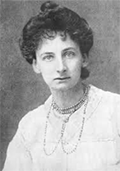
One woman who suffered such indignities was Lady Constance Lytton, a member of high society who wanted to vote. She disguised herself as a poor woman and then got herself arrested speaking out for suffrage and endured the hardship of suffragettes in prison. She went on a hunger strike and was finally released. She then told her story, saying that several times while she was in prison, the guards had told her that if she were rich or otherwise had connections, she could leave anytime she liked. Even more, advocates of women's suffrage argued, this set of events illustrated the disparity between privileges afford to members of different classes.  It was also in 1913 that a member of the women's suffrage movement gave her life for the cause, although she didn't plan it that way. Emily Davison had been arrested nine teams, gone on hunger strike seven times, and been force fed 49 times by 1913. That wasn't what killed her. At the Derby that year, she ran out onto the track during the race and tried to drape a suffrage banner over Anmer, the horse of King George V. Her sudden appearance on the track spooked the horse, the jockey was unable to control the horse, and it trampled Davison. She was severely injured, spent a few nights at a hospital, and died there. An outpouring of sympathy from some sectors of society greeted Davison and her plight; she also received hate mail during her few days in hospital. 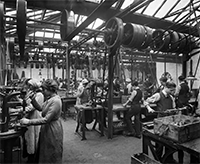
Members of both high-profile groups, the NUWSS and the WSPU, suspended their suffrage campaigns during World War I and supported the home front activities, such as helping look after the families of veterans and augmenting the work of military nurses. Women also worked in factories and did other jobs that had been previously done only by men. In 1918, Parliament expanded suffrage for male voters. The primary impetus for expanding the number of men who could vote in the waning days of the war was the realization that current laws did not allow the men who had survived the horrors of war and made it home to then be able to vote. At the same time, while those men and the other who didn't make it back were away fighting, women stepped up and did many of the jobs that were reserved for men and so many men were convinced that women had earned the right to have the vote. 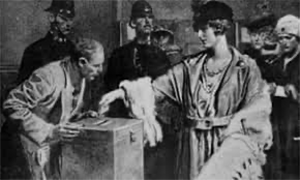
Parliament agreed, in part. The Reform Act 1918 did give the vote to women, just not all of them. This bill that brought monumental change was the final step in bringing universal suffrage to men. And, it was the first bill to grant the right to vote to women. The only remaining qualification for a man to be able to vote was that he be 21 or older. Women who wanted to vote had to own property (or be the wife of a property owner), and be 30 or older. This amounted to an addition of 6 million women to the voter rolls. The leaders of the suffrage movement kept the pressure on their elected officials, employing all manner of strategies to press their case that what they were being denied was a fundamental right. Their long years of marching, campaigning, gathering signatures for petitions, protesting, enduring force feeding as a result of hunger strikes, and many other activities had finally resulted in the achievement of their goal, in part. Ten years later, they achieved the final goal. 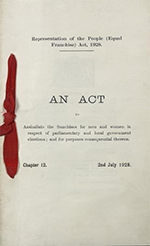
The 1928 bill, known also as the Fifth Reform Act or the Equal Suffrage Act, was a simple idea yet a powerful emancipation. For the first time, all women were equal under the law to all men–at least as far as those 21 and over. The bill became law by Royal Assent on July 2, 1928. The onetime NUWSS leader Millicent Fawcett was still alive to see the final victory won. (WSPU leader Emmeline Pankhurst had died just weeks before the bill became law.) First page > The Lay of the Land > Page 1, 2 |
|
Social Studies for Kids
copyright 2002–2025
David White



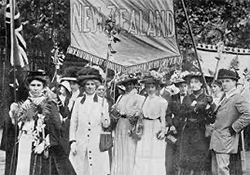 In 1893, New Zealand became
In 1893, New Zealand became 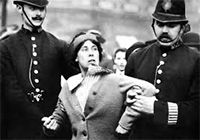 lines, setting fire to unoccupied houses, sending letter bombs, chaining themselves to railway lines, and destroying greenhouses at Kew Gardens. More and more arrests followed, and women in prison adopted the hunger strike as a method of continuing their protest while behind bars. Prison authorities responded by force-feeding women on hunger strike, and this whole set of events garnered great sympathy for the women who suffered through such things.
lines, setting fire to unoccupied houses, sending letter bombs, chaining themselves to railway lines, and destroying greenhouses at Kew Gardens. More and more arrests followed, and women in prison adopted the hunger strike as a method of continuing their protest while behind bars. Prison authorities responded by force-feeding women on hunger strike, and this whole set of events garnered great sympathy for the women who suffered through such things.
